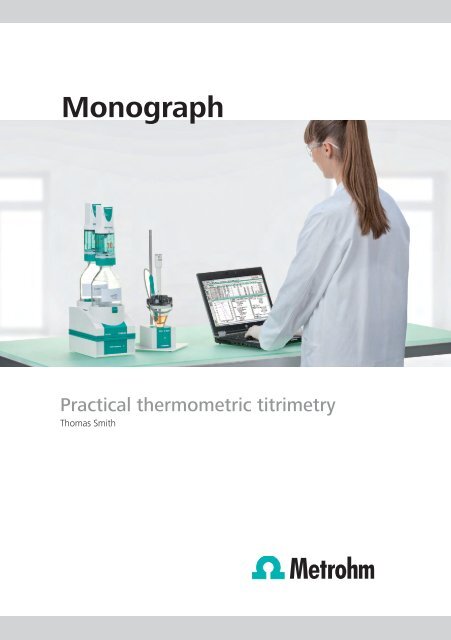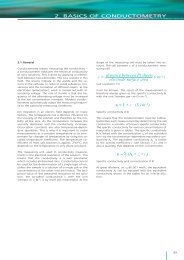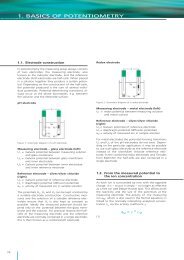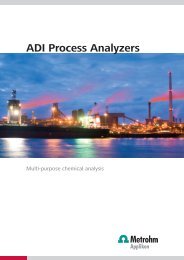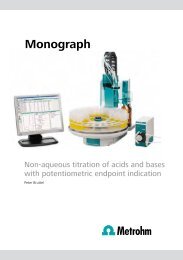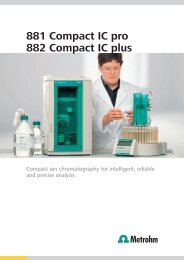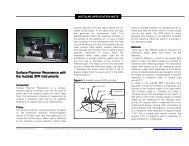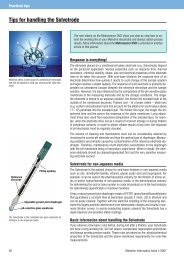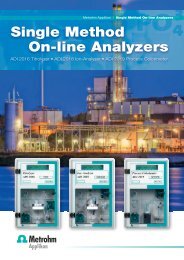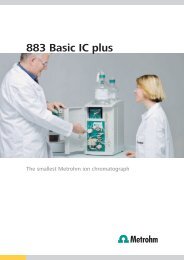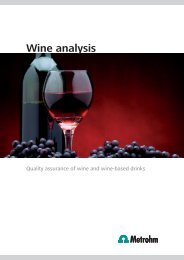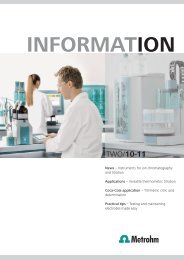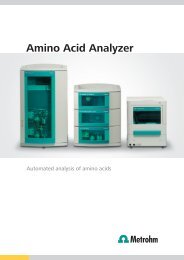Monograph - Metrohm
Monograph - Metrohm
Monograph - Metrohm
Create successful ePaper yourself
Turn your PDF publications into a flip-book with our unique Google optimized e-Paper software.
<strong>Monograph</strong><br />
Practical thermometric titrimetry<br />
Thomas Smith
Practical thermometric titrimetry<br />
Thomas Smith<br />
<strong>Metrohm</strong> Ltd.<br />
CH-9101 Herisau/Switzerland<br />
Phone +41 71 353 85 85<br />
Fax +41 71 353 89 01<br />
www.metrohm.com<br />
All rights reserved, including those of translation.<br />
Printed by <strong>Metrohm</strong> Ltd., CH-9101 Herisau, Switzerland<br />
8.036.5003 – 2006-06
Practical thermometric titrimetry 3<br />
Contents<br />
1. Foreword............................................................................................................... 5<br />
2. Introduction.......................................................................................................... 6<br />
3. Theory and background to thermometric titrimetry........................................ 6<br />
3.1. Comparison between potentiometric and thermometric titrations..................... 6<br />
3.2. Thermometric titrations..................................................................................... 7<br />
4. Apparatus and setup for automated thermometric titrimetry........................ 12<br />
5. Optimization of thermometric titration parameters....................................... 14<br />
5.1. Physical titration conditions……………………………………………………... 14<br />
5.1.1. Mixing……………………………………………………………………….. 14<br />
5.1.2. Probe orientation…………………………………………………………..... 14<br />
5.1.3. Data density………………………………………………………………..... 14<br />
5.1.4. Optimizing titration results with software………………………………...... 15<br />
6. Titrant calibration and determination of the method blank............................ 17<br />
6.1. Determination of method blank……………………………………………….... 17<br />
6.2. Determination of titrant concentration………………………………………..... 17<br />
7. Types of thermometric titration....................................................................... 20<br />
7.1. Acid-base titrations......................................................................................... 20<br />
7.1.1. Determination of fully dissociated acids and bases.................................... 20<br />
7.1.2. Titration of weak acids.............................................................................. 21<br />
7.1.3. Titration of acid mixtures........................................................................... 21<br />
7.1.4. Titration of complex alkaline solutions....................................................... 22<br />
7.1.5. Non-aqueous acid-base titrations.............................................................. 23<br />
7.1.6. Catalyzed endpoint thermometric acid-base titrations............................... 24<br />
7.2. Redox titrations............................................................................................... 24<br />
7.2.1. Titrations with permanganate and dichromate.......................................... 24<br />
7.2.2. Titrations with thiosulfate.......................................................................... 25<br />
7.2.3. Hypochlorite as a titrant............................................................................ 25<br />
7.3. Complexometric (EDTA) titrations.................................................................... 25<br />
7.4. Precipitation titrations..................................................................................... 28<br />
7.4.1. Titration of sulfate..................................................................................... 28<br />
7.4.2. Titration of aluminum with fluoride........................................................... 28<br />
7.4.3. Titration of total orthophosphate.............................................................. 28<br />
7.4.4. Titration of nickel...................................................................................... 29<br />
7.4.5. Titration of anionic and cationic surfactants.............................................. 29<br />
7.4.6. Titration of non-ionic surfactants............................................................... 30<br />
7.5. Miscellaneous aqueous titrations..................................................................... 30<br />
7.5.1. Titration of fluoride with boric acid........................................................... 30<br />
7.5.2. Determination of formaldehyde................................................................. 31<br />
7.6. Thermometric titration of water......................................................................... 31<br />
7.6.1. Advantages of the DMP thermometric method......................................... 32<br />
7.6.2. Limitations of the DMP thermometric method........................................... 33<br />
7.6.3. Moisture determinations with triethyl orthoformate.................................. 33<br />
References............................................................................................................... 34<br />
Bibliography............................................................................................................ 34
Practical thermometric titrimetry 5<br />
1. Foreword<br />
This monograph is intended primarily for practicing industrial analytical chemists as an<br />
introduction to the technique of thermometric titrimetry. The main purpose is to describe<br />
the basics of the technique as well as a range of applications that are suitable<br />
for use with the 859 Titrotherm thermometric titration system. Theoretical aspects are<br />
discussed only briefly, and readers seeking a more detailed exposition are encouraged to<br />
seek out the references listed in the bibliography as well as conducting searches in the<br />
academic literature. Examples chosen to illustrate various thermometric titration applications<br />
are from the author’s own experiments.
Practical thermometric titrimetry<br />
2. Introduction<br />
Titration is a technique in analytical chemistry with a history dating to the mid-18 th century.<br />
It may be defined as the reaction of a known volume of a reactant with a known<br />
concentration (the titrant) with another reactant contained in a sample (the analyte or<br />
titrand) to determine the amount of the analyte in the sample. The point at which stoichiometric<br />
amounts of titrant have been added to the sample is known as the equivalence<br />
point. The volume of titrant measured at this point is used to compute the amount<br />
of analyte present in the sample. The classical titration methods employ color change<br />
due to chemical indicators to determine the endpoint. The practical problems in the<br />
correct, unequivocal determination of endpoints based on the subjective interpretation<br />
of color change by the analyst have been recognized for many years, and analysts have<br />
sought alternative methods of precisely determining endpoints.<br />
Thermometric titrimetry is one of a number of instrumental titration techniques where<br />
endpoints can be located accurately and precisely without a subjective interpretation on<br />
the part of the analyst. Enthalpy change is a universal property of chemical reactions.<br />
Accordingly, the observation of temperature change is a valid possibility for monitoring<br />
their progress.<br />
This monograph commences with a brief discussion of some theoretical aspects of thermometric<br />
titrimetry followed by some practical considerations and finally by an introduction<br />
to some of the many applications.<br />
3. Theory and background to thermometric<br />
titrimetry<br />
3.1. Comparison between potentiometric and thermometric titrations<br />
Potentiometric titrimetry has been the predominant automated titrimetric technique for<br />
the past half-century, so it is worthwhile considering the basic differences between it<br />
and thermometric titrimetry.<br />
Potentiometric (and conductometric) titrations rely on a free energy change in the reaction<br />
system. Measurement of a free energy dependent term is necessary.<br />
G 0<br />
= –R T lnK G0 = –R T lnK<br />
(1)<br />
Where:<br />
Δ G 0 = change in free energy<br />
R<br />
T<br />
K<br />
= universal gas constant<br />
= temperature in K<br />
= equilibrium constant at temperature T<br />
H 0 = G 0 + TS<br />
0 (2)
Practical thermometric titrimetry 7<br />
In order for a reaction Gto 0 be = amenable –R T lnK to potentiometric titrimetry, the free energy (1) change<br />
must be sufficient for an appropriate sensor to respond with a significant inflection in the<br />
curve where sensor G 0 response = –R is T plotted lnK against the amount of titrant delivered. (1)<br />
However, free energy is just one of three related parameters in describing any chemical<br />
reaction:<br />
Where:<br />
H 0 = G 0 + TS 0 (2)<br />
H 0 = G 0 + TS<br />
0 (2)<br />
Δ H 0 = change in enthalpy<br />
Δ G 0 = change in free energy<br />
Δ S 0 = change in entropy<br />
T<br />
= temperature in K<br />
For any reaction where Where: the free energy H 0 is not = change opposed by in enthalpy the entropy change, the enthalpy<br />
change will be significantly greater than the free energy. Thus a titration based<br />
on a change in Where: temperature (which H<br />
G 0 0 = change in free energy<br />
permits observation of the enthalpy change) will<br />
S 0 = change in enthalpy<br />
show a greater inflection than will Gcurves 0 = obtained change<br />
= change<br />
from in free<br />
in entropy<br />
sensors energy reacting to free energy<br />
changes alone.<br />
S<br />
T 0 = change<br />
= temperature<br />
in entropy<br />
in K<br />
T = temperature in K<br />
3.2. Thermometric titrations<br />
In a thermometric titration, titrant is added at a known constant rate to an analyte until<br />
the completion of the reaction is indicated by a change in temperature. The endpoint<br />
is determined by an inflection in the curve generated by the output of a temperature<br />
measuring device.<br />
Consider the titration reaction:<br />
aA + bB pP (3)<br />
aA + bB pP (3)<br />
Where: A = titrant a = corresponding number of moles reacting<br />
B = analyte<br />
b = corresponding number of moles reacting<br />
P = product<br />
p = corresponding number of moles produced<br />
At completion, the reaction produces a molar heat of reaction ΔH r , which is shown as a<br />
measurable temperature change ΔT. In an ideal system, where no losses or gains of heat<br />
due to environmental influences* are involved, the progress of the reaction is observed<br />
as a constant increase or decrease of temperature depending respectively on whether<br />
ΔH r is negative (indicating an exothermic reaction) or positive (indicating an endothermic<br />
reaction).<br />
* Among «environmental influences» may be categorized:<br />
– Heat losses or gains from outside the system via the vessel walls and cover<br />
– Differences in the temperature between the titrant and the analyte<br />
– Evaporative losses from the surface of the rapidly mixed fluid<br />
– Heat of solution when the titrant solvent is mixed with the analyte solvent<br />
– Heat introduced by the mechanical action of stirring (minor influence)<br />
– Heat produced by the thermistor itself (very minor influence)
Practical thermometric titrimetry<br />
If the equilibrium for the reaction lies far to the right (i.e. a stoichiometric equilibrium has<br />
been achieved), then when all analyte has been reacted by the titrant continuing addition<br />
of titrant will be revealed by a sharp break in the temperature/volume curve. Figures<br />
1a and 1b illustrate idealized examples.<br />
Fig. 1a: Exothermic reaction<br />
Fig. 1b: Endothermic reaction<br />
Fig. 1: Idealized thermometric titration curves for stoichiometric reaction equilibria.<br />
Volume of titrant added plotted versus temperature of the solution.<br />
The shape of experimentally obtained thermometric titration plots will vary from such<br />
idealized examples, and some of the environmental influences listed above may have<br />
impacts. Curvature at the endpoint might be observed. This can be due to insensitivity<br />
of the sensor or slow adjustment of the thermal equilibrium at the endpoint. There are<br />
also cases where the reaction between titrant and analyte does not proceed to stoichiometric<br />
completion. The determinant of the degree to which a reaction will proceed to<br />
completion is the free energy change. If this is favorable, then the reaction will proceed<br />
to completion and be essentially stoichiometric. In this case, the sharpness of the curve<br />
at the endpoint is dependent on the magnitude of the enthalpy change. If the free energy<br />
change is unfavorable, the curve at the endpoint will be rounded regardless of the<br />
magnitude of the enthalpy change.<br />
Reactions where non-stoichiometric equilibria are evident can be used to obtain satisfactory<br />
results using a thermometric titration approach. If the portions of the titration<br />
curve both prior to and after the endpoint are reasonably linear, then the intersection of<br />
tangents to these lines will accurately locate the endpoint. This is illustrated in Figure 2.<br />
Fig. 2: Representation of a thermometric titration curve<br />
for a reaction with a non-stoichiometric equilibrium.
Practical thermometric titrimetry 9<br />
Consider the reaction for the equation aA + bB pP, which is non-stoichiometric at<br />
equilibrium. Let A represent the titrant, and B the analyte. At the beginning of the titration,<br />
the analyte B is strongly in excess and the reaction is pushed towards completion.<br />
Under these conditions, for a constant rate of titrant addition the temperature increase is<br />
constant and the curve is essentially linear until the endpoint is approached. In a similar<br />
manner, when the titrant is in excess past the endpoint, a linear temperature response<br />
can also be anticipated. Thus intersection of tangents will reveal the true endpoint.<br />
An actual thermometric titration plot for the determination of a strong base with a<br />
strong acid is illustrated in Figure 3.<br />
Fig. 3: Typical thermometric titration plot of<br />
an exothermic reaction. The volume of titrant<br />
added is plotted on the x-axis and the<br />
temperature of the solution on the y-axis.<br />
The most practical sensor for measuring temperature changes in titration solutions has<br />
been found to be the thermistor. Thermistors are small solid-state devices manufactured<br />
from sintered mixed-metal oxides that exhibit relatively large changes in electrical resistance<br />
for small changes in temperature. The thermistor is encapsulated in a suitable electrically<br />
insulating medium with satisfactory heat transfer characteristics and acceptable<br />
chemical resistance. Typically for thermistors used for chemical analysis the encapsulating<br />
medium is glass, although thermistors encapsulated in epoxy resin may be used in<br />
circumstances where either chemical attack (e.g. by acidic fluoride-containing solutions)<br />
or severe mechanical stress is anticipated (see Figure 4). The thermistor is supported by<br />
a suitable electronic circuit to maximize the sensitivity to minute changes in the solution<br />
temperature. The circuitry in the 859 Titrotherm is capable of resolving temperature<br />
changes as low as 10 –5 K.<br />
Fig. 4: Glass-encapsulated thermistor of the<br />
Thermoprobe.
10 Practical thermometric titrimetry<br />
A critical element in modern automated thermometric titrimetry is the ability to locate the<br />
endpoint with a high degree of reproducibility. The endpoint is determined by derivatization<br />
of the temperature curve. The second derivative essentially locates the intersection<br />
of tangents to the temperature curve immediately before and after the breakpoint.<br />
Thermistors respond quickly to small changes in temperature such as temperature gradients<br />
in the mixed titration solution. The signal can therefore exhibit a small amount of<br />
noise. Prior to derivatization it is therefore necessary to digitally smooth (or «filter») the<br />
temperature curve in order to obtain sharp, symmetrical second derivative «peaks» that<br />
will accurately locate the correct inflection point. This is illustrated in Figure 5.<br />
Fig. 5: Location of a thermometric titration<br />
endpoint using the second derivative of a<br />
digitally smoothed temperature curve.<br />
The degree of digital smoothing is optimized for each determination and is stored as a<br />
method parameter for application every time a titration for that particular analysis is run.<br />
Thermometric titrations generally demand rapid reaction kinetics in order to obtain sharp<br />
reproducible endpoints. Where reaction kinetics are slow, and direct titrations between<br />
titrant and analyte are not possible, indirect or back-titrations often can be used to solve<br />
the problem.<br />
Catalytically enhanced endpoints can be helpful in some instances where the temperature<br />
change at the endpoint is very small and endpoints would not be detected satisfactorily<br />
by the titration software.<br />
The suitability of a particular chemical reaction as a candidate for a thermometric titration<br />
procedure can generally be predicted on the basis of the estimated amount of analyte<br />
present in the sample and the enthalpy of the reaction. However, other parameters<br />
such as the kinetics of the reaction, the sample matrix itself, heats of dilution and losses<br />
of heat to the environment can affect the outcome. A properly designed experimental<br />
program is the most reliable way of determining the viability of a thermometric titration<br />
approach. Successful applications for thermometric titrations are generally where titrantanalyte<br />
reaction kinetics are fast and chemical equilibria are stoichiometric or nearly so.
Practical thermometric titrimetry 11<br />
Thermometric titration may be recommended where:<br />
• The titration environment is considered unsuitable for conventional titration sensors.<br />
For example, glass membrane pH electrodes must be kept adequately hydrated for<br />
proper operation. The use of such electrodes in substantially non-aqueous media as<br />
in the determination of trace acids in lipids and lubricating oils can lead to loss of performance<br />
as the membrane fouls and dehydrates, and/or if the reference junction is<br />
partly or completely blocked. It is often necessary to keep a number of electrodes cycling<br />
through a rejuvenation program in order to keep up with an analytical workload.<br />
Thermometric sensors have no electrochemical interaction with the titration solution<br />
and therefore can be used (also for titrations in non-conducting media) on a continuous<br />
basis with essentially no maintenance.<br />
• No suitable reference electrode or diaphragm can be found. This can be either because<br />
there is no suitable reference electrolyte available or the diaphragm of the reference<br />
electrode is blocked by the sample matrix.<br />
• A thermometric titration methodology that cannot be emulated using other types of<br />
titration sensors delivers superior or otherwise unobtainable results. Examples are the<br />
determination of fluoride by titration with boric acid, the analysis of orthophosphate by<br />
titration with magnesium ions, and the direct titration of aluminum with fluoride ions.<br />
The applications described in this monograph may serve as a guide to the analyst in<br />
determining whether automated thermometric titrations may be profitably employed in<br />
his or her laboratory.
12 Practical thermometric titrimetry<br />
4. Apparatus and setup for automated<br />
thermometric titrimetry<br />
A suitable setup for automated thermometric titrimetry comprises the following:<br />
• Precision fluid dispensing devices – burets – for adding titrants and dosing of other<br />
reagents<br />
• Thermistor-based thermometric sensor<br />
• Titration vessel<br />
• Stirring device, capable of highly efficient stirring of vessel contents without splashing<br />
• Computer with thermometric titration operating system<br />
• Thermometric titration interface module – this regulates the data flow between the<br />
burets, sensors and the computer<br />
Figure 6 illustrates an automated thermometric titration system based on the 859 Titrotherm<br />
interface module with Thermoprobe sensor, 800 Dosino dispensing devices and a<br />
computer running the operational software.<br />
Fig. 6: Basic thermometric titration system featuring 859 Titrotherm interface module and 800 Dosino dispensing<br />
devices.
Practical thermometric titrimetry 13<br />
Fig. 7: Schematic of the relationship between the components in an automated thermometric titration system.<br />
A = dosing device<br />
B = thermometric sensor<br />
C = stirring device<br />
D = thermometric titration interface module<br />
E = computer
14 Practical thermometric titrimetry<br />
5. Optimization of thermometric titration<br />
parameters<br />
5.1. Physical titration conditions<br />
5.1.1. Mixing<br />
The thermistors used in the Thermoprobe thermometric probes employed with Titrotherm<br />
have a response time of approximately 0.3 seconds. Most of the instrumental<br />
noise evident in thermometric titrations is thus due to the detection of temperature gradients<br />
in the stirred titration solution. Minimization of instrumental noise can therefore<br />
be obtained by using stirring speeds as high as possible consistent with the avoidance of<br />
splashing. Some compromise to stirring speed might be necessary when working with<br />
determinations where very little heat is evolved or absorbed, and where environmental<br />
influences such as solvent evaporation might have a deleterious impact.<br />
5.1.2. Probe orientation<br />
It has been observed by a number of workers in the field of thermometric titration that<br />
there is an optimum placement of the thermistor probe and the buret delivery tip in the<br />
titration vessel. This is at the periphery of the titration vessel, with the thermistor upstream<br />
of the delivery tip when referred to the direction of flow in the vessel.<br />
This relative placement permits the thorough mixing and thus most efficient reaction of<br />
titrant and analyte.<br />
5.1.3. Data density<br />
Richter and Tinner (2001) have emphasized the importance of data density around titration<br />
breakpoints in order to define endpoints precisely. It has been stated previously<br />
that thermometric titrations are conducted at constant titrant addition rates, and so the<br />
practice of slowing down the titrant addition rates in potentiometric «dynamic titrations»<br />
to obtain higher data densities around breakpoints is not an option. Instead, the<br />
Titrotherm thermometric titration software permits data density to be preset before the<br />
start of the titration. The data density stays constant over the entire titration. With Titrotherm<br />
software, the analyst has the option of altering the sampling rate of the output<br />
from the thermometric sensor in the range of 5 to 25 times per second. The maximum<br />
permissible number of data points that can be collected during the course of a titration is<br />
32’000. The data sampling rate is matched to the anticipated titrant consumption and to<br />
the titrant addition rate of the determination. Table 1 indicates the relationship between<br />
titrant consumption, data sampling rate and titrant addition rate. Higher titrant addition<br />
rates demand concomitantly higher data sampling rates with the converse applying for<br />
lower titrant addition rates.
Practical thermometric titrimetry 15<br />
Table 1: Relationship between anticipated titrant consumption and sensor data sampling rate.<br />
Anticipated titrant<br />
consumption, mL<br />
Data sampling<br />
rate, 1/sec<br />
Titrant addition<br />
rate, mL/min<br />
Data points<br />
collected<br />
0…3 25 1 0…4500<br />
3…7.5 10 1.5 1200…3000<br />
7.5…10 10 2 2250…3000<br />
5.1.4. Optimizing titration results with software<br />
The Titrotherm software employs a powerful data-smoothing algorithm that exhibits a<br />
minimum endpoint shift as a function of the degree of filtering applied. However, it is<br />
inevitable that some shift will occur. For highest accuracy and precision this shift should<br />
be taken into consideration. For thermometric titrations, endpoint shift appears to be less<br />
pronounced in titration reactions involving large enthalpy changes with fast reaction kinetics.<br />
For example, redox and strong acid/strong base titrations usually exhibit a minimal<br />
endpoint shift. Apart from these, some reactions may require more careful optimization.<br />
Figure 8 and Table 2 illustrate the effect of the filter factor on the endpoint peak shape<br />
and the endpoint shift. The titration illustrated was the determination of nickel using<br />
sodium dimethylglyoximate as titrant.<br />
Fig. 8 a: Filter factor = 20 Fig. 8 b: Filter factor = 50<br />
Fig. 8 c: Filter factor = 80 Fig. 8 d: Filter factor = 100<br />
Figures 8 a – d: Effect of filter factor on endpoint derivative peak.
16 Practical thermometric titrimetry<br />
For a rigorous optimization, an examination of the effect of filter factor on the titrant<br />
consumption of the determination should be undertaken. Table 2 and Figure 9 illustrate<br />
this process.<br />
Table 2: Titrant consumption determined at the endpoint as a function of the filter factor.<br />
Filter Factor<br />
Titrant<br />
consumed, mL<br />
Filter Factor<br />
20 4.829 70 4.843<br />
30 4.836 80 4.831<br />
40 4.837 90 4.832<br />
50 4.836 100 4.818<br />
60 4.837 110 4.814<br />
Titrant<br />
consumed, mL<br />
By plotting the filter factor (x-axis) against the titrant consumption determined (y-axis),<br />
it can be seen in the example illustrated in Figure 9 that stable endpoint values are obtained<br />
over a filter factor range of 30…60. An optimal filter factor could thus be found<br />
in the range 40…50.<br />
Fig. 9: Determination of the optimal filter factor.
Practical thermometric titrimetry 17<br />
6. Titrant calibration and determination<br />
of the method blank<br />
This chapter deals with the optimum determination of the accuracy of the volume of<br />
titrant delivered to the endpoint and the concentration of the titrant.<br />
As has been discussed previously, thermometric titrations are conducted under conditions<br />
of a constant titrant addition rate. In this respect they differ from potentiometric titrations,<br />
where the titrant addition rate may be varied during the titration according to the electrode<br />
response. In thermometric titrations, a constant addition rate of titrant equates to a<br />
constant amount of heat being given out or consumed, and hence a more or less constant<br />
temperature change up to the endpoint. Ideally, the temperature of the solution should<br />
be transmitted to the computer and processed instantaneously throughout the titration.<br />
Practically this is not the case and it takes a finite time before a change in temperature of<br />
the solution is received, computed and recorded. Since titrant is added at a constant rate,<br />
this time delay in the passage and processing of temperature information is expressed as<br />
a volume of titrant. Delays from various sources including the ones cited below affect the<br />
exact volume of titrant needed and hence the exact location of the endpoint:<br />
• Inefficiencies in the mixing of the titration solution<br />
• Reaction kinetics (in the case of non-ionic titrations)<br />
• Heat transfer delays across the thermistor cladding and in the thermistor bead itself<br />
• Electronic and software processing delays.<br />
Furthermore, the shape of the inflection or breakpoint at the endpoint of the titration<br />
and the slopes of the temperature curve prior to and post the endpoint all have an impact<br />
on the optimum location of the endpoint as determined by the second derivative<br />
curve, and this has to be considered along with time delays in determining the actual<br />
amount of titrant consumed to the endpoint.<br />
For given sets of titration conditions, these errors are constant and can be quantified as<br />
a single parameter – the titration method blank. This parameter is stored along with the<br />
other method parameters and is subtracted from all determinations of the volume of<br />
titrant needed in these particular titrations.<br />
6.1. Determination of method blank<br />
The method blank is determined by titrating under previously optimized conditions a<br />
number of analyte solutions of different concentrations and plotting the analyte concentration<br />
against the titrant consumption. The method blank is determined as the y-<br />
intercept from a linear regression of the titration data. Changes in method parameters<br />
will require a new determination of the method blank.<br />
6.2. Determination of titrant concentration<br />
The titrant concentration is conveniently determined at the same time as the method<br />
blank using a standard solution of analyte titrated under the same conditions considered<br />
optimum for titration of actual samples. Where the analyte is not a primary standard, it<br />
should be substituted by an appropriate primary standard.
18 Practical thermometric titrimetry<br />
The procedure of the determination of the titrant concentration may be summarized as<br />
follows:<br />
• Write the chemical equation describing the reaction of the standard analyte with the<br />
titrant.<br />
• Determine the number of moles of analyte reacting with one mole of titrant.<br />
• Starting from an appropriate solution of a primary standard, prepare a range of<br />
amounts of analyte either by direct weighing or by serial dilution. The amounts of<br />
analyte present in this series of secondary standard solutions should encompass at<br />
least the normal range anticipated to be found in actual samples. Moreover, reasonable<br />
amounts of titrant have to be needed for titration.<br />
For example, during initial experimentation and optimization it may be found that aliquots<br />
of sample solution give titrant volumes needed in the range 2…4 mL. The range<br />
of standards chosen should therefore span at least say 1…5 mL. Generally for thermometric<br />
titrations, a maximum titrant consumption of 5…6 mL is suitable, but with<br />
some chemistries whose reaction enthalpies are modest, a maximum titrant consumption<br />
of only 2.5…5 mL may be advisable. Conversely, redox titrations exhibiting very<br />
high reaction enthalpies can tolerate higher maximum volumes of titrant consumed,<br />
say 10…12 mL. Overall, there is little to be gained in terms of analytical precision by<br />
employing large volumes of titrant required. Usually any gains made in using a high<br />
titrant volume to be added, are offset by decreases in the replication of the results. At<br />
least four standards should be used in the calibration process.<br />
• If the primary standard is a liquid, use a series of high quality bulb pipets to deliver the<br />
aliquots. A suitable series may be 2, 3, 4, 5 and 10 mL or 5, 10, 15, 20 and 25 mL.<br />
The pipets should be freshly cleaned with a suitable laboratory glass cleaning agent<br />
and rinsed with deionized water prior to use. The choice of a set of pipets and the<br />
corresponding concentration of the standard analyte solution will be influenced by<br />
the volume of any reagent solutions that need to be added.<br />
For example, if you have to prepare buffered standard solutions of 25 mL each, then<br />
choose a pipet set of 2, 3, 4, 5 and 10 mL for transferring the required aliquots of<br />
primary standard to the flasks, add the necessary buffer solution volume (e.g. 10 mL)<br />
and make up to the mark with ultrapure water.<br />
• If a solid primary standard is used, weigh it in on an analytical balance to ±0.1 mg.<br />
• Set up the regression plot with the millimoles of analyte (contained in each prepared<br />
standard solution) plotted on the x-axis and milliliters of titrant consumed plotted on<br />
the y-axis.<br />
• The plot will be a linear curve of the form y = ax + b, where the method blank is<br />
represented by the intercept b, and the molarity of the titrant is calculated from the<br />
gradient a. Table 3 gives some examples of how the molarity of the analyte may be<br />
calculated.
Practical thermometric titrimetry 19<br />
Table 3: Examples of the calculation of the molarity of the titrant from the determination of titrant concentration<br />
by regression analysis.<br />
Analyte Titrant Reaction Molarity<br />
NaOH HCl NaOH + HCl NaCl + H 2 O 1 divided by gradient<br />
H 2 SO 4 NaOH H 2 SO 4 + 2NaOH Na 2 SO 4 + 2 H 2 O 2 divided by gradient<br />
Al 3+ F – Al 3+ + Na + + 2K + + 6F – NaK 2 AlF 6 6 divided by gradient<br />
An example of this approach to the determination of both method blank and titrant<br />
molarity is the thermometric titration of aluminum with fluoride ions. A primary standard<br />
solution of aluminum is made by dissolution of high-purity aluminum metal. Aliquots of<br />
this solution have been taken to prepare the diluted standard solutions. By plotting the<br />
aluminum ion concentration of these standards against the required volume of fluoride<br />
ion titrant, Figure 10 is obtained. The regression was carried out using the linear regression<br />
function in Microsoft Excel.<br />
Fig. 10: Example of a calibration curve.<br />
Results of regression analysis:<br />
Gradient = 6.30520 mL/mmol<br />
Y-intercept (method blank) = 0.0264 mL<br />
Correlation coefficient (R 2 ) = 0.999997<br />
Calculation of NaF molarity:<br />
Molarity = 6 divided by gradient<br />
(because 6 moles fluoride ion react with 1<br />
mole aluminum ion).<br />
Molarity = 6 / 6.30520 = 0.9516 mol/L NaF<br />
Therefore the diluted NaF standard solutions have a titer of:<br />
An advantage of this approach is that not only two critical parameters can be determined<br />
at the same time, but also the analyst has the opportunity to check the linearity<br />
of response over the measurement range in question.
20 Practical thermometric titrimetry<br />
7. Types of thermometric titration<br />
Thermometric titrimetry can be used for the following reaction types:<br />
• Acid-base (acidimetry and alkalimetry)<br />
• Redox<br />
• Precipitation<br />
• Complexometric<br />
Because the sensor does not interact electrically or electrochemically with the solution,<br />
electrical conductance of the titrating medium is not a prerequisite for a successful determination.<br />
Titrations may be carried out in completely non-conducting, non-polar media<br />
if required. Further, titrations may be carried out in turbid solutions or even suspensions<br />
of solids. Titrations where precipitates are formed can also be carried out.<br />
7.1. Acid-base titrations<br />
7.1.1 Determination of fully dissociated acids and bases<br />
The heat of neutralization of a fully dissociated acid with a fully dissociated base (see<br />
Figure 11) is approximately –56 kJ/mol and can be calculated as a standard enthalpy of<br />
reaction using standard enthalpies of formation.<br />
H + + OH – H 2 O<br />
ΔH 0 f (kJ/mol) 0 –230.0 –285.8 ΔH 0 r = –55.8 kJ/mol<br />
Fig. 11: Titration of NaOH with<br />
1 mol/L HCl.<br />
The reaction is strongly exothermic and thus provides an excellent basis for a wide range<br />
of analyses in industry. An advantage for the industrial analyst is that the use of stronger<br />
titrants (1…2 mol/L) permits a reduction of the sample preparation effort. Samples can<br />
often be directly and accurately dispensed into the titration vessel prior to titration.
Practical thermometric titrimetry 21<br />
Hydrogen carbonate can be unequivocally determined in the presence of carbonate by<br />
titration with hydroxyl ions (see Figure 12). The standard enthalpy of reaction is approximately<br />
–41 kJ/mol.<br />
–<br />
HCO 3 + OH – 2–<br />
CO 3 + H 2 O<br />
ΔH 0 f (kJ/mol) –692.0 –230.0 –677.1 –285.8 ΔH 0 r = –40.9 kJ/mol<br />
Fig. 12: Titration of HCO 3<br />
–<br />
in company<br />
with CO 3<br />
2–<br />
by 1 mol/L NaOH.<br />
7.1.2. Titration of weak acids<br />
Weakly dissociated acids yield sharp endpoints when titrated with a strong base (see<br />
Figure 13).<br />
Formic acid Citric acid Total acids in apple juice<br />
Fig. 13: Titration of weak acids with 1 mol/L NaOH.<br />
7.1.3. Titration of acid mixtures<br />
Mixtures of complex acids can be resolved by thermometric titration with standard<br />
NaOH in aqueous solution (see Figure 14 and Table 4). In a mixture of nitric, acetic and<br />
phosphoric acids used in the fabrication of semiconductors, three endpoints could be<br />
predicted on the basis of the dissociation constants of the acids:
22 Practical thermometric titrimetry<br />
Endpoint 1 Endpoint 2 Endpoint 3<br />
HNO 3<br />
(pK a = –1.3)<br />
HOAc<br />
(pK a = 4.75)<br />
H 3 PO 4<br />
(pK a1 = 2.12)<br />
H 3 PO 4<br />
(pK a2 = 7.21)<br />
H 3 PO 4<br />
(pK a3 = 12.36)<br />
Table 4: pK a values in a mixture of nitric, acetic and phosphoric acids.<br />
The key to determine the amount of each acid present in the mixture is the ability to<br />
obtain an accurate value for the amount of phosphoric acid present, as revealed by titration<br />
of the third proton of H 3 PO 4 .<br />
Figure 14 illustrates a titration plot of this mixture, showing 3 sharp endpoints.<br />
Fig. 14: Titration of a mixture of<br />
nitric, acetic and phosphoric acid<br />
with 2 mol/L NaOH.<br />
7.1.4. Titration of complex alkaline solutions<br />
The thermometric titration of sodium aluminate liquor (Bayer liquor) in the production<br />
of alumina from bauxite is accomplished in an automated two titration sequence. This<br />
is an adaptation of a classic thermometric titration application (VanDalen and Ward,<br />
1973). In the first titration, tartrate solution is added to an aliquot of liquor to complex<br />
the aluminate, releasing one mole of hydroxyl ions for each mole of aluminate present.<br />
The carbonate ions along with the released and «free» hydroxyl ions are titrated acidimetrically<br />
in a second titration (see Part 1 of Figure 15). The second titration is preceded<br />
by the automatic addition of fluoride solution. The alumina-tartrate complex is broken<br />
in favor of the formation of an aluminum fluoride complex and the concomitant release<br />
of three moles of hydroxyl ions for each mole of aluminum ions present, which are then<br />
titrated acidimetrically (see Part 2 of Figure 15). The whole determination can be completed<br />
in less than 5 minutes.
Practical thermometric titrimetry 23<br />
Part 1: Titration of the total hydroxyl and<br />
carbonate content.<br />
Part 2: Titration of the hydroxyl ions equivalent<br />
to the aluminum content.<br />
Fig. 15: Titration plots for the determination of «total caustic», «total soda» and «alumina» in alumina refinery liquors.<br />
7.1.5. Non-aqueous acid-base titrations<br />
Non-aqueous acid-base titrations can be carried out advantageously by thermometric<br />
means.<br />
Acid leach solutions from some copper mines can contain large quantities of Fe(III) as<br />
well as Cu(II). The «free acid» (sulfuric acid) content of these leach solutions is a critical<br />
process parameter. While thermometric titrimetry can determine the free acid content<br />
with modest amounts of Fe(III), in some solutions the Fe(III) content is so high as to cause<br />
serious interference. Complexation with necessarily large amounts of oxalate is undesirable<br />
due to the toxicity of the reagent. A thermometric titration was devised by diluting<br />
the aliquot with 2-propanol (isopropyl alcohol, propan-2-ol) followed by titration with<br />
standard KOH in 2-propanol. As a result, most of the metal content precipitated prior to<br />
the start of the titration, and a clear, sharp endpoint indicating the sulfuric acid content<br />
was obtained (see Figure 16).<br />
Fig. 16: Determination of free H 2 SO 4 in copper<br />
leach solution by titration in 2-propanol with 1<br />
mol/L KOH in 2-propanol.
24 Practical thermometric titrimetry<br />
7.1.6. Catalyzed endpoint thermometric acid-base titrations<br />
The determination of trace acids in organic matrices is a common analytical task assigned<br />
to titrimetry. Examples are Total Acid Number (TAN) in mineral and lubricating oils and Free<br />
Fatty Acids (FFA) in edible fats and oils. Automated potentiometric titration procedures<br />
have been granted standard method status, for example by ASTM for TAN and AOAC for<br />
FFA. The methodology is similar in both instances. The sample is dissolved in a suitable solvent<br />
mixture and the trace acids are titrated with standard base dissolved in an alcohol.<br />
A recent thermometric titrimetric procedure for the determination of FFA developed by<br />
Cameiro et al (2002) has been shown to be particularly amenable to automation. It is not<br />
only fast and highly precise but also the results agree very well with those obtained by<br />
the official AOAC method. In Cameiro’s procedure, a small amount of paraformaldehyde<br />
is added as a fine powder to the sample solution before the titration. Without this addition,<br />
the temperature change for the titration of very weak acids such as oleic acid by<br />
0.1 mol/L KOH in 2-propanol would be too small to yield an accurate endpoint. At the<br />
endpoint, the first excess of hydroxyl ions catalyzes the hydrolysis of paraformaldehyde.<br />
The reaction is strongly endothermic and yields a sharp inflection. The titration plot is<br />
illustrated in Figure 17.<br />
Fig. 17: Catalyzed endpoint thermometric<br />
titration of free fatty acids in tallow – hydroxyl-catalyzed<br />
endothermic hydrolysis of<br />
paraformaldehyde.<br />
7.2. Redox titrations<br />
7.2.1. Titrations with permanganate and dichromate<br />
Redox reactions are normally strongly exothermic and can make excellent candidates<br />
for thermometric titrations. Consider the classical determination of ferrous ions with<br />
permanganate:<br />
–<br />
MnO 4 + 8 H + + 5 Fe 2+ 5 Fe 3+ + Mn 2+ + 4 H 2 O<br />
ΔH 0 f (kJ/mol) 1 x –541.4 0 5 x –89.1 5 x –48.5 1 x –220.8 4 x –285.8<br />
ΔH 0 r = –123.9 kJ/mol Fe 2+
Practical thermometric titrimetry 25<br />
The determination of hydrogen peroxide by permanganate titration is even more strongly<br />
exothermic:<br />
–<br />
2 MnO 4 + 6 H + + 5 H 2 O 2 5 O 2 + 2 Mn 2+ + 8 H 2 O<br />
ΔH 0 f (kJ/mol) 2 x –541.4 0 5 x –89.1 5 x –11.7 2 x –220.8 8 x –285.8<br />
ΔH 0 r = –149.6 kJ/mol H 2 O 2<br />
This reaction is catalyzed by the presence of Mn 2+ . To avoid a sudden surge of temperature<br />
shortly after commencement of the titration, it is necessary to add a minute amount<br />
of Mn 2+ prior to the start.<br />
Other common titrants used in redox titrimetry can be employed. Due to its purity and<br />
stability, potassium dichromate has been used successfully as a titrant in the determination<br />
of Fe(II) and ascorbic acid (vitamin C).<br />
7.2.2. Titrations with thiosulfate<br />
In the determination of hypochlorite (for example in commercial bleach formulations), a direct<br />
titration with thiosulfate can be employed without recourse to an iodometric finish.<br />
Thermometric iodometric titrations employing thiosulfate as a titrant are also practical,<br />
for example in the determination of Cu(II). In this instance, it has been found advantageous<br />
to incorporate the potassium iodide reagent with the thiosulfate titrant in such<br />
proportions that iodine is released into solution just prior to its reduction by thiosulfate.<br />
This minimizes iodine losses during the course of the titration.<br />
7.2.3. Hypochlorite as a titrant<br />
While relatively unstable and requiring frequent determinations of the titer, sodium hypochlorite<br />
has been used in a very rapid thermometric titration method for the determination<br />
of ammonium. This is an alternative to the classical approach of ammonia distillation<br />
from basic solution and consequent acid-base titration. The thermometric titration<br />
is carried out in hydrogen carbonate solution containing bromide (Brown et al, 1969).<br />
3 OCl – + 2 NH 4<br />
+<br />
2 H + + 3 Cl – + N 2 + 3 H 2 O<br />
7.3. Complexometric (EDTA) titrations<br />
Thermometric titrations employing sodium salts of ethylenediaminetetra-acetic acid<br />
(EDTA) have been demonstrated for the determination of a range of metal ions. Reaction<br />
enthalpies are modest, so titrations are normally carried out with titrant concentra-
26 Practical thermometric titrimetry<br />
tions of 1 mol/L. This necessitates the use of the tetrasodium salt of EDTA rather than<br />
the more common disodium salt, which is saturated at a concentration of only approximately<br />
0.25 mol/L.<br />
An excellent application is the sequential determination of calcium and magnesium.<br />
Although calcium reacts exothermically with EDTA (heat of chelation approximately<br />
–23.4 kJ/mol), magnesium reacts endothermically with a heat of chelation of approximately<br />
+20.1 kJ/mol. This is illustrated in the titration plot of EDTA with calcium and<br />
magnesium in sea water (Figure 18). Following the solution temperature curve, the<br />
breakpoint for the calcium content (endpoint on the left in Figure 18) is followed by<br />
a region of modest temperature rise due to competition between the heats of dilution<br />
of the titrant with the solution, and the endothermic reaction of Mg 2+ and EDTA. The<br />
breakpoint for the consumption of Mg 2+ (endpoint on the right in Figure 18) by EDTA is<br />
revealed by an upswing in temperature purely caused by heat of dilution.<br />
Fig. 18: EDTA titration of calcium and<br />
magnesium in sea water.<br />
Direct EDTA titrations with metal ions are possible when reaction kinetics is fast as is the<br />
case with zinc, copper, calcium and magnesium. However, with slower reaction kinetics<br />
such as those exhibited by cobalt and nickel, back-titrations are used. Titrations for cobalt<br />
and nickel are carried out in an ammoniacal environment; buffered with ammonia/<br />
ammonium chloride solution. An excess of EDTA is added and back-titrated with Cu(II)<br />
solution (see Figure 19). It is postulated that the breakpoint is revealed by the difference<br />
in reaction enthalpies between the formation of the Cu-EDTA complex, and that for the<br />
formation of the Cu-ammine complex.
Practical thermometric titrimetry 27<br />
Fig. 19: Titration plot of back-titration<br />
of excess EDTA with Cu(II) in<br />
NH 3 /NH 4 Cl-buffered solution.<br />
A catalyzed endpoint procedure to determine trace amounts of metal ions in solution<br />
(down to approximately 10 mg/L) employs 0.01 mol/L EDTA. This has been applied to<br />
the determination of low level Cu(II) in specialized plating baths and to the determination<br />
of total hardness in water. The reaction enthalpies of EDTA with most metal ions are<br />
often quite low. Therefore titrant concentrations typically around 1 mol/L are employed<br />
with correspondingly high amounts of analyte in order to obtain sharp, reproducible<br />
endpoints. Using a catalytically indicated endpoint in combination with a back-titration,<br />
very low EDTA titrant concentrations can be used. An excess of EDTA solution is added.<br />
The excess of EDTA is back-titrated with a suitable metal ion such as Mn 2+ or Cu 2+ . At the<br />
endpoint, the first excess of metal ion catalyzes a strongly exothermic reaction between<br />
a polyhydric phenol (such as resorcinol) and hydrogen peroxide (see Figure 20).<br />
Fig. 20: Thermometric EDTA titration<br />
of trace Cu(II) by back-titration with<br />
Mn(II), in combination with catalytically<br />
enhanced endpoint detection<br />
using the exothermic reaction<br />
between hydrogen peroxide and a<br />
polyhydric phenol.
28 Practical thermometric titrimetry<br />
7.4. Precipitation titrations<br />
Thermometric titrimetry is particularly suited to the determination of a range of analytes<br />
where a precipitate is formed by reaction with the titrant. It may be employed for applications<br />
that cannot be satisfactorily analyzed by potentiometric titrimetry.<br />
7.4.1. Titration of sulfate<br />
Sulfate may be rapidly and easily titrated thermometrically using standard solutions of<br />
Ba 2+ as titrant. Industrially, the procedure has been applied to the determination of sulfate<br />
in brine (including electrolysis brines), in nickel refining solutions and particularly<br />
for sulfate in wet process phosphoric acid, where it has proven to be quite popular. The<br />
procedure can also be used to assist in the analysis of complex acid mixtures containing<br />
sulfuric acid where resorting to titration in non-aqueous media is not feasible.<br />
The reaction enthalpy for the formation of barium sulfate is a modest –18.8 kJ/mol. This<br />
can place a restriction on the lower limit of sulfate in a sample that can be analyzed.<br />
7.4.2. Titration of aluminum with fluoride<br />
Thermometric titrimetry offers a rapid, highly precise method for the determination of<br />
aluminum in solution. A solution of aluminum is conditioned with acetate buffer and an<br />
excess of sodium and potassium ions. Titration with sodium or potassium fluoride yields<br />
the exothermic precipitation of an insoluble alumino-fluoride salt.<br />
Al 3+ + Na + + 2 K + + 6 F –<br />
K 2 NaAlF 6 <br />
Because 6 mol of fluoride react with one mol of aluminum, the titration is particularly precise,<br />
and a coefficient of variance (CV) of 0.03 has been achieved in the analysis of alum.<br />
When aluminum ions (say as aluminum nitrate) are employed as the titrant, fluoride can<br />
be determined using the same chemistry. This titration is useful in the determination of<br />
fluoride in complex acid mixtures used as etchants in the semiconductor industry.<br />
7.4.3. Titration of total orthophosphate<br />
Orthophosphate ions can be conveniently thermometrically titrated with magnesium<br />
ions in the presence of ammonium ions. An aliquot of sample is buffered to approximately<br />
pH 10 with an NH 3 /NH 4 Cl solution.<br />
The reaction:<br />
Mg 2+ + 3–<br />
+ NH 4 + PO 4<br />
MgNH 4 PO 4<br />
is exothermic. CV’s of under 0.1 have been achieved in test applications. The procedure<br />
is suitable for the determination of orthophosphate in fertilizers and other products.
Practical thermometric titrimetry 29<br />
7.4.4. Titration of nickel<br />
Nickel can be titrated thermometrically using disodium dimethylglyoximate as titrant.<br />
The chemistry is analogous to the classic gravimetric procedure, but the time taken for<br />
a determination can be reduced from many hours to a few minutes. Potential interferences<br />
need to be considered.<br />
7.4.5. Titration of anionic and cationic surfactants<br />
Anionic and cationic surfactants can be determined thermometrically by titrating one<br />
type against the other. For instance, benzalkonium chloride (a quaternary type cationic<br />
surfactant) may be determined in cleaners and algaecides for swimming pools and spas<br />
by titrating with a standard solution of sodium dodecyl sulfate (see Figure 21a). Alternatively,<br />
anionic surfactants such as sodium lauryl sulfate can be titrated with cetyl pyridinium<br />
chloride (see Figure 21b).<br />
.<br />
Fig. 21 a: Titration of benzalkonium chloride<br />
with sodium dodecyl sulfate<br />
Fig. 21 b: Titration of sodium lauryl sulfate in<br />
shampoo by titration with cetyl pyridinium<br />
chloride. Acetonitrile added to repress micellerelated<br />
phenomena. Note sudden rise in temperature<br />
immediately prior to the endpoint.
30 Practical thermometric titrimetry<br />
Thermometric titrimetry offers an opportunity to observe the influence of micelles on<br />
the conduct of the determination. To avoid the influence of micelle-related phenomena<br />
on the outcome of the titration, it is sometimes necessary to add a suitable solvent such<br />
as acetonitrile.<br />
7.4.6. Titration of non-ionic surfactants<br />
When an excess of Ba 2+ is added to a non-ionic surfactant of the alkyl propylene oxide<br />
derivative type, a pseudo-cationic complex is formed. This may be titrated with standard<br />
sodium tetraphenylborate (see Figure 22). Two moles tetraphenylborate react with one<br />
mole of the Ba 2+ / non-ionic surfactant complex.<br />
Fig. 22: Thermometric titration of a<br />
non-ionic surfactant in a formulation<br />
containing an anionic surfactant.<br />
7.5. Miscellaneous aqueous titrations<br />
7.5.1. Titration of fluoride with boric acid<br />
Acidic solutions of fluoride (including hydrofluoric acid) can be determined by a simple<br />
thermometric titration with boric acid.<br />
B(OH) 3 + 3 F – + 3 H +<br />
BF 3 + 3 H 2 O<br />
The titration plot illustrated in Figure 23 shows that the endpoint is quite rounded, suggesting<br />
that the reaction might not proceed to stoichiometric equilibrium. However,<br />
since the regions of the temperature curve immediately before and after the endpoint<br />
are quite linear, the second derivative of this curve (representing the intersection of tangents)<br />
will accurately locate the endpoint. Indeed, excellent precision can be obtained<br />
with this titration, with a CV of less than 0.1.
Practical thermometric titrimetry 31<br />
Fig. 23: Titration plot of the determination<br />
of fluoride with boric acid.<br />
7.5.2. Determination of formaldehyde<br />
Formaldehyde can be determined in electroless copper plating solutions by the addition<br />
of an excess of sodium sulfite solution and titrating the liberated hydroxyl ion with<br />
standard acid.<br />
H 2 C=O + SO 3<br />
2–<br />
+ H 2 O [HO–CH 2 –SO 3– ] + OH –<br />
7.6. Thermometric titration of water<br />
The thermometric titration of water using Karl Fischer (KF) reagent is feasible due to<br />
the large reaction enthalpy involved (approx. –67 kJ/mol). However, other workers have<br />
sought to avoid some of the disadvantages and limitations inherent in the use of the KF<br />
reagent. Sadtler and Wilson (ca. 1980) developed a thermometric titration technique relying<br />
on the endothermic acid-catalyzed reaction of 2,2-dimethoxypropane (DMP) with<br />
water.<br />
H +<br />
CH 3 C(CH 3 O) 2 CH 3 + H 2 O 2CH 3 OH + (CH 3 ) 2 CO<br />
ΔH 0 f (kJ/mol) –459.4 –285.8 2 x –239.2 –239.2<br />
ΔH 0 r = +27.6 kJ/mol<br />
The reagent had seen prior use in the dehydration of histological specimens, and in infrared<br />
and gas chromatographic methods for the determination of water. DMP is of low<br />
toxicity, quite stable, not hygroscopic and only reacts with water in the presence of an<br />
acid. The reaction products (acetone and methanol) are relatively benign. Many applications<br />
have been demonstrated, including the determination of water in concentrated<br />
acids (where the acid itself provides the catalyst for the reaction) (see Figures 24 a and<br />
24 b). Methane sulfonic acid may be used as a catalyst in many applications.
32 Practical thermometric titrimetry<br />
Fig. 24 a: Plot of thermometric titration of water<br />
in concentrated hydrochloric acid using DMP as<br />
titrant.<br />
Fig. 24 b: Thermometric determination of moisture<br />
in commercial (ultrafine) cobalt oxyhydroxide.<br />
An excess of added DMP is back-titrated<br />
with a standard solution of water in 2-propanol.<br />
Rounding of the endpoint suggests that the reaction might not proceed to stoichiometric<br />
equilibrium. Inspection of titration curves shows that, as expected, the reaction is<br />
driven closer to stoichiometric equilibrium when water is determined in strong acids.<br />
7.6.1. Advantages of the DMP thermometric method:<br />
• DMP is stable and essentially non-hygroscopic, does not react with water until catalyzed<br />
with acid. Does not require special conditions in storage<br />
• DMP is of low toxicity, reaction products are relatively benign<br />
• Analysis can be integrated with other thermometric titration procedures simply by<br />
adding an additional buret to the system<br />
• Solvent system can be adjusted to suit the sample – a range of anhydrous organic<br />
solvents and mixtures thereof can be used<br />
• Applicable to a wide range of sample types, particularly those that are acidic or neutral<br />
in character. Samples analyzed have ranged from plant oils with moistures in the range<br />
of 0.02…0.04% to concentrated HCl with a water content of 67%<br />
• Can be useful for analysis of samples where Karl Fischer or other methods have not<br />
proven suitable
Practical thermometric titrimetry 33<br />
7.6.2. Limitations of the DMP thermometric method:<br />
• High titration blanks may limit precision of procedure. Contributing factors to high<br />
blanks might be non-stoichiometry at equilibrium and/or residual moisture in solvents.<br />
• Less well suited to analysis of moisture in basic samples<br />
• Best results usually obtained with short titrations and a volume of titrant added generally<br />
less than 2 mL and frequently even less than 1 mL. This can affect the precision of<br />
the method.<br />
7.6.3. Moisture determinations with triethyl orthoformate<br />
Ortho esters such as triethyl orthoformate (TEOF) have been shown to be superior to<br />
DMP in the gas chromatographic determination of water (Chen & Fritz, 1991). The authors<br />
confirmed the non-stoichiometric equilibrium of the reaction of DMP with water.<br />
Ortho esters react with water in a similar manner to DMP, yielding a carboxylic ester and<br />
an alcohol.<br />
HC(OCH 2 CH 3 ) 3 + H 2 O<br />
H +<br />
HCOOCH 2 CH 3 + 2CH 3 CH 2 OH<br />
TEOF has been tested as a possible alternative to DMP in a number of applications, notably<br />
the determination of moisture in automotive engine oils. A typical thermometric titration<br />
plot of this application is shown in Figure 25. While the endpoint is subjectively sharper<br />
than that obtained with a DMP titration, the level of signal noise is clearly higher. This is<br />
undoubtedly due to the very modest changes in solution temperature experienced during<br />
the titration and the magnification of temperature variations in the stirred vessel.<br />
Fig. 25: Thermometric titration plot of the<br />
determination of water in automotive engine<br />
oil with triethyl orthoformate.
34 Practical thermometric titrimetry<br />
REFERENCES:<br />
1. M. W. Brown, K. Issa, G. Sinclair. Precise manual enthalpimetric titrations. Analyst,<br />
94, 234–235 (1969)<br />
2. J. Chen and J. S. Fritz. Gas chromatographic determination of water after reaction<br />
with triethyl orthoformate. Anal. Chem. 63 (18), 2016–2020 (1991)<br />
3. W. Richter and U. Tinner. Practical aspects of modern titration <strong>Metrohm</strong> <strong>Monograph</strong><br />
8.016.5003 (2001)<br />
4. E. VanDalen and L. G. Ward. Thermometric titration determination of hydroxide and<br />
alumina in Bayer process solutions. Anal. Chem. 45 (13), 2248–2251 (1973)<br />
5. M. J. D. Carneiro, M. A. Feres Júnior, and O. E. S. Godinho. Determination of the<br />
acidity of oils using paraformaldehyde as a thermometric endpoint indicator. J. Braz.<br />
Chem. Soc. 13 (5), 692–694 (2002)<br />
6. T. K. Smith. Analysis of FFA in edible oils by catalyzed endpoint thermometric titrimetry.<br />
JAOCS 80, 21–24 (2003)<br />
7. G. A. Vaughan and J. J. Swithenbank. Exothermic condensation of acetone to<br />
diacetone alcohol. Analyst 90, 594–599 (1965)<br />
BIBLIOGRAPHY:<br />
(All of the following books are out of print, but might be available from academic libraries<br />
or through second-hand book sellers such as Amazon.com)<br />
1. G. A. Vaughan (1973) Thermometric and enthalpimetric titrimetry. Van Nostrand<br />
Reinhold Company (London) ISBN 0-442-78385-X; Library of Congress Catalog Card<br />
No. 79-186764<br />
2. L. S. Bark and S. M. Bark (1969). Thermometric titrimetry. International Series of<br />
<strong>Monograph</strong>s in Analytical Chemistry vol. 33, Pergamon Press (Oxford); Library of<br />
Congress Catalog Card No. 68-57883<br />
3. J. Barthel (1975) Thermometric titrations. John Wiley & Sons, New York. ISBN 0-471-<br />
05448-8; Library of Congress Catalog Card No. 75-17503<br />
4. J. K. Grime (1985) Analytical solution calorimetry. John Wiley & Sons, New York.<br />
ISBN 0-471-86942-2; Library of Congress Catalog Card No. 84-28424<br />
5. D. J. Eatough, J. J. Christensen, R. M. Izatt (1974) Experiments in thermometric<br />
titrimetry and titration calorimetry. Brigham Young University Press, Provo, Utah.<br />
ISBN 0-8425-0145-2; Library of Congress Catalog Card 74-13074


